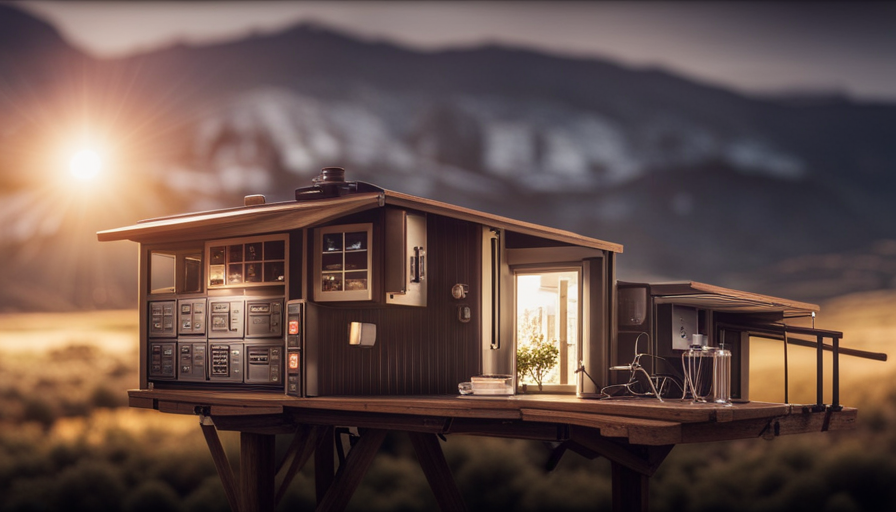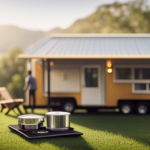In the vast world of real estate, where bigger is usually seen as better, there is a noticeable trend towards valuing the simplicity and charm of tiny homes. These compact living spaces offer a unique lifestyle, challenging us to reconsider our ideas about space and possessions. However, before embarking on building or buying a tiny home, it is crucial to understand a crucial aspect: its weight.
Just as a feather’s weight can determine its flight, the weight of a tiny house holds significant implications for its design, transportation, and overall structural integrity. In this article, I will delve into the factors that affect the weight of a tiny house, explore methods to calculate its weight accurately, and discuss lightweight design options and transportation considerations. I will also provide valuable tips for reducing the weight and highlight the pros and cons of a lighter versus a heavier tiny house.
By the end, you will have a comprehensive understanding of how a tiny house weighs and why it matters.
Key Takeaways
- Factors affecting the weight of a tiny house include weight distribution, lightweight construction, and strategic placement of heavy items.
- Materials used, foundation type, and overall design significantly impact the weight limits and towing capacity of a tiny house.
- Lightweight building materials, compact and energy-efficient appliances, and minimalist furnishing choices contribute to reducing the weight of a tiny house and improving energy efficiency.
- Proper weight distribution is crucial for structural integrity, stability, and safety in a tiny house.
Factors Affecting the Weight of a Tiny House
So, how exactly does a tiny house weigh? Understanding the weight of a tiny house is crucial for designing and building a safe and structurally sound structure. There are several factors that affect the weight of a tiny house, and understanding them is essential.
One important factor is weight distribution. The distribution of weight in a tiny house is critical for maintaining stability and preventing structural issues. By strategically placing heavy items like appliances and furniture near the center of the house, the weight can be evenly distributed, reducing the risk of tilting or tipping over.
Another factor is the benefits of lightweight construction. Using lightweight materials such as aluminum or composite panels can significantly reduce the overall weight of the house. This not only makes it easier to tow or transport the tiny house but also decreases the stress on the foundation and other structural components.
Understanding weight limits and structural considerations is essential when designing a tiny house. By adhering to weight limits set by transportation regulations and considering the strength and integrity of the materials used, you can ensure the safety and longevity of your tiny house.
Understanding the factors affecting the weight of a tiny house, such as weight distribution and lightweight construction, is crucial for designing a safe and efficient structure. Now, let’s delve into the next section about understanding weight limits and structural considerations.
Understanding Weight Limits and Structural Considerations
When determining weight limits and structural considerations for a tiny house, it’s crucial to take into account various factors such as materials used, foundation type, and overall design. These factors can greatly affect the mobility of the tiny house as well as its impact on towing capacity.
The choice of materials, whether it’s wood, steel, or a combination, can significantly impact the weight of the structure. Additionally, the type of foundation, such as a trailer or a permanent foundation, can also affect the weight and structural integrity of the tiny house.
The overall design of the tiny house plays a crucial role in determining its weight limits. Factors like the number of floors, the size of the windows, and the presence of additional features like a loft or a rooftop garden can all contribute to the overall weight of the tiny house. It’s important to carefully consider these factors to ensure that the tiny house remains within safe weight limits and maintains its structural stability.
Understanding these weight limits and structural considerations is essential when designing and building a tiny house. By carefully considering the materials used, foundation type, and overall design, one can ensure that the tiny house remains within safe weight limits and has minimal impact on towing capacity.
In the next section, we will explore how to calculate the weight of a tiny house without compromising its structural integrity.
How to Calculate the Weight of a Tiny House
To accurately determine the weight of your compact dwelling, you should engage in a meticulous calculation process that takes into account the materials used, foundation type, and overall design. One important aspect to consider is calculating weight distribution, which involves determining how the weight is distributed throughout the tiny house. This is crucial for maintaining structural integrity and ensuring that the weight is evenly distributed to prevent any excessive stress on certain areas.
To help you understand the various factors that contribute to the weight of a tiny house, I have created a table below:
| Materials | Weight (lbs) |
|---|---|
| Wood | 10,000 |
| Steel | 8,000 |
| Concrete | 12,000 |
| Fiberglass | 7,000 |
By adding up the weights of all the materials used in your tiny house, you can get an estimate of its total weight. Additionally, it is important to consider the foundation type, as different types have different weight-bearing capacities.
One of the benefits of lightweight construction is that it allows for easier transportation of the tiny house. Lighter materials can reduce the overall weight, making it easier to tow or move the dwelling.
In the next section, we will explore lightweight design options for tiny houses, which can further optimize the weight and portability of your compact living space.
Lightweight Design Options for Tiny Houses
When designing a tiny house, one must consider lightweight building materials as a key option. These materials not only reduce the overall weight of the structure but also increase energy efficiency.
Additionally, choosing compact and energy-efficient appliances is essential to maximize space and minimize energy consumption.
Lastly, minimalist furnishing and decor choices contribute to a lightweight design by reducing clutter and unnecessary weight.
Using Lightweight Building Materials
If you want to keep the weight of your tiny house to a minimum, you should consider using lightweight building materials. Lightweight insulation options, such as spray foam or aerogel, can provide excellent thermal performance while adding minimal weight to the overall structure.
Additionally, using composite materials, like fiberglass or carbon fiber, for the walls, roof, and floors can significantly reduce the weight of the tiny house without compromising its strength and durability. These materials are known for their high strength-to-weight ratio, making them ideal for constructing lightweight structures.
By incorporating lightweight building materials, you can not only achieve a lighter tiny house but also improve its energy efficiency and reduce transportation costs.
Moving on to the next section about choosing compact and energy-efficient appliances, it is important to consider their impact on the overall weight of the tiny house.
Choosing Compact and Energy-Efficient Appliances
Compact and energy-efficient appliances can help maximize space and reduce energy consumption in your tiny home. When choosing appliances for your tiny house, it’s important to consider their size and energy efficiency ratings. Compact appliance options, such as slim refrigerators and stackable washer-dryer combos, can save valuable space without sacrificing functionality. Additionally, energy-efficient appliance choices, like ENERGY STAR rated dishwashers and air conditioners, can help lower your electricity bills and minimize your environmental impact. To provide a clear comparison of different appliances, here is a table showcasing their dimensions and energy usage:
| Appliance | Dimensions (inches) | Energy Usage (kWh/year) |
|---|---|---|
| Refrigerator | 24x24x48 | 300 |
| Washer-Dryer | 24x24x33 | 500 |
| Dishwasher | 18x18x32 | 250 |
| Air Conditioner | 16x16x9 | 400 |
By carefully selecting compact and energy-efficient appliances, you can create a more efficient and comfortable living space in your tiny home. This transition into the next section about minimalist furnishing and decor choices emphasizes the importance of considering every aspect of your tiny house’s design.
Minimalist Furnishing and Decor Choices
To create a truly minimalist and stylish atmosphere in your tiny home, consider opting for sleek furnishings and decor choices that reflect your personal style.
Minimalist interior design is all about simplicity and functionality. Choose furniture pieces that serve multiple purposes, such as a sofa that can also be used as a bed or a coffee table with hidden storage compartments. Space-saving furniture options are key in maximizing the limited space available in a tiny house.
Look for foldable chairs, wall-mounted tables, and floating shelves to optimize storage and create a sense of openness. Additionally, focus on a neutral color palette and clean lines to maintain a cohesive and uncluttered look. By making deliberate choices in your furnishings and decor, you can transform your tiny house into a stylish haven that perfectly embodies your personal taste and preferences.
As you consider the interior design of your tiny home, it’s important to also think about transportation considerations for tiny houses.
Transportation Considerations for Tiny Houses
When considering transportation for tiny houses, it’s important to understand how much they weigh. The weight of a tiny house is a crucial factor that determines the type of transportation method that can be used.
The weight distribution of a tiny house is typically evenly distributed to ensure stability during transport. This is achieved by strategically placing heavy items, such as appliances and furniture, near the center of the house.
One of the benefits of tiny house living is its lightweight nature. Most tiny houses weigh between 5,000 to 10,000 pounds, making them much lighter compared to traditional houses. This reduced weight allows for easier transportation and more flexibility in choosing the transportation method.
Tiny houses can be transported using a variety of methods, including flatbed trailers, tow trucks, and even shipping containers.
Transporting a tiny house requires careful planning and consideration. It is important to ensure that the transportation method is suitable for the weight and dimensions of the house. Additionally, securing the house properly during transport is crucial to avoid any damage or accidents.
Understanding the weight of a tiny house is essential when considering transportation options. The lightweight nature of tiny houses offers numerous benefits, including ease of transportation and flexibility. With proper planning and consideration, transporting a tiny house can be a smooth and successful process.
Moving on to the next topic, let’s delve into the maintenance and upkeep of a tiny house.
Maintenance and Upkeep of a Tiny House
Taking care of a tiny house is essential for ensuring its longevity and comfort, just like any other home. For example, imagine waking up on a chilly winter morning in your cozy tiny house, knowing that you’ve taken the necessary steps to properly insulate it, keeping you warm and comfortable throughout the season.
When it comes to maintenance, there are a few key tips to keep in mind. Firstly, regular inspections are crucial. Check for any signs of damage or wear and tear, such as leaks, cracks, or pests. Addressing these issues promptly can prevent them from escalating and becoming more expensive to fix.
Secondly, maintaining the exterior of your tiny house is important for both aesthetic and functional reasons. Regularly clean and repaint the exterior to protect it from the elements and prevent deterioration.
Lastly, consider the cost considerations of maintaining a tiny house. Budget for regular maintenance tasks and factor in potential repairs to avoid any financial surprises.
In the subsequent section about tips for reducing the weight of a tiny house, it’s important to consider practical strategies that can help optimize its overall weight and increase its mobility.
Tips for Reducing the Weight of a Tiny House
One way to shed some pounds off your compact abode is by carefully selecting lightweight building materials. When it comes to reducing weight in a tiny house, maximizing efficiency is key. Every pound counts, so it’s important to choose materials that are strong and durable, yet lightweight.
For example, using materials such as aluminum or composite panels for the walls instead of traditional wood can significantly reduce the overall weight of the house. Additionally, opting for lightweight insulation materials like spray foam or rigid foam boards can help minimize the weight without compromising on energy efficiency.
Another effective strategy for reducing weight is to carefully plan the layout and design of your tiny house. By optimizing the use of space and avoiding unnecessary features, you can minimize the need for extra materials and reduce the overall weight. For instance, incorporating built-in storage solutions and multi-functional furniture can help eliminate the need for bulky items and save on weight.
Reducing weight in a tiny house requires careful consideration of building materials and efficient design. By selecting lightweight materials and maximizing space utilization, you can effectively shed pounds off your compact abode.
In the next section, we will discuss common mistakes to avoid when estimating weight without compromising structural integrity.
Common Mistakes to Avoid When Estimating Weight
Carefully calculating the weight of a compact living space is crucial to ensure its structural integrity and avoid costly mistakes. When estimating the weight of a tiny house, it’s important to strive for accuracy.
One common mistake to avoid is underestimating the weight of the materials used in construction. It’s essential to consider the weight of the framing, insulation, roofing, siding, and all other components. By accurately estimating the weight of each element, you can ensure that your tiny house won’t exceed its maximum load capacity.
Another mistake to avoid is neglecting to account for weight distribution. Even if the total weight of your tiny house falls within the acceptable range, improper weight distribution can lead to structural issues. It’s essential to distribute the weight evenly across the foundation and axles to maintain stability and prevent sagging or leaning.
Taking the time to carefully estimate the weight of your tiny house and considering weight distribution will help you avoid costly mistakes in the long run. By ensuring the accuracy of your calculations, you can build a structurally sound and safe living space.
Transitioning to the next section, it’s important to understand the pros and cons of having a lighter or heavier tiny house.
The Pros and Cons of a Lighter vs. Heavier Tiny House
Considering the weight of a compact living space, it’s crucial to weigh the advantages and disadvantages of a lighter versus a heavier tiny home.
When it comes to constructing a tiny house, the weight plays a significant role in its overall mobility and portability. A lighter construction offers several benefits. Firstly, it allows for easier towing and transportation, as it puts less strain on the vehicle pulling it. Additionally, a lighter tiny house requires a smaller tow vehicle, which can save on fuel costs.
On the other hand, a heavier tiny house may offer better insulation and durability. It can withstand harsh weather conditions and provide a more stable living environment. However, the increased weight can limit mobility and make it more challenging to move the house from one location to another.
In conclusion, understanding the weight of a tiny house is essential in determining the right balance between mobility and durability. By carefully considering the advantages and disadvantages of a lighter versus a heavier construction, one can make an informed decision based on their specific needs and preferences.
Conclusion: Understanding the Weight of a Tiny House
When it comes to understanding the weight of a tiny house, there are several key points to consider.
First and foremost, proper weight distribution is of utmost importance to ensure stability and safety.
Balancing functionality and weight considerations is also crucial in order to maximize the use of space while minimizing the stress on the structure.
Lastly, living in a tiny house offers the freedom and flexibility to travel and explore, allowing for a truly unique and liberating lifestyle.
Importance of Proper Weight Distribution
To ensure your tiny house is stable and safe, it’s crucial that you evenly distribute the weight throughout the structure. Proper weight distribution is essential for maintaining the structural integrity of your tiny house.
Here are two key factors to consider when it comes to weight distribution:
-
Vertical distribution: By evenly distributing the weight vertically, you prevent excessive stress on any particular area of the structure. This helps maintain the overall balance and stability of the tiny house.
-
Sub-factor 1: Consider the placement of heavy appliances and furniture on both the lower and upper levels.
-
Sub-factor 2: Use strong and reliable support systems, such as beams and joists, to ensure the weight is evenly distributed across the entire structure.
-
-
Horizontal distribution: Distributing the weight evenly from side to side is equally important. This prevents the tiny house from leaning or tipping over, especially during transportation.
Balancing functionality and weight considerations is crucial in creating a well-designed and structurally sound tiny house.
Balancing Functionality and Weight Considerations
Finding the perfect balance between practicality and the weight of your tiny abode can be a delicate dance, but fear not, for we’ve got some tricks up our sleeve. When it comes to furniture selection, it’s crucial to choose pieces that aren’t just functional but also lightweight.
Opt for multi-purpose furniture that serves multiple functions, such as a sofa that can also be used as a bed or a dining table that can be folded away when not in use.
Additionally, considering the structural integrity of your tiny house is paramount. Make sure that the materials used in construction are sturdy enough to support the weight of the furniture and the occupants.
By carefully selecting furniture and maintaining structural integrity, you can strike the perfect balance between functionality and weight considerations. This allows you to enjoy the freedom and flexibility of living in a tiny house without compromising on comfort or safety.
Enjoying the Freedom and Flexibility of Living in a Tiny House
When it comes to living in a tiny house, there are many aspects to consider. In the previous subtopic, we discussed the importance of balancing functionality and weight considerations. Now, let’s delve into the current subtopic, which focuses on enjoying the freedom and flexibility of living in a tiny house.
Living in a tiny house offers a unique experience that combines both freedom and limitations. On one hand, you have the freedom to live a more minimalist lifestyle, with fewer possessions and fewer financial burdens. This allows for a greater sense of freedom and the flexibility to live a more fulfilling life. However, downsizing to a tiny house also presents its challenges. Limited space requires careful planning and organization to make the most of every square inch. It forces you to prioritize and let go of unnecessary items. But in doing so, you gain the freedom to focus on what truly matters and live a more intentional and purposeful life.
| Freedom | Limitations |
|---|---|
| Minimalist lifestyle | Downsizing challenges |
| Financial freedom | Limited space |
| Flexibility | Prioritization |
| Intentional living | Letting go of unnecessary items |
Frequently Asked Questions
Are there any legal weight limits or restrictions for towing a tiny house?
Yes, there are legal weight limits and restrictions for towing a tiny house. These limits vary depending on the specific jurisdiction and the type of vehicle used for towing. It’s important to consider the weight distribution of the tiny house to ensure safe and stable towing. Proper weight distribution can be achieved by placing heavier items closer to the axles and distributing the weight evenly from side to side. Adhering to these guidelines is crucial for a successful and legal towing experience.
How can I ensure that the weight of my tiny house is evenly distributed for structural integrity?
To ensure stability and proper weight distribution in my tiny house, I must first consider the center of gravity. This is crucial for structural integrity.
By strategically placing heavy items closer to the center and lighter items towards the edges, I can maintain balance.
Additionally, using weight distribution techniques such as load equalization hitches and sway control systems will enhance stability while towing.
These measures will guarantee a safe and secure journey for my tiny house.
Can I add an additional level or extra rooms to my tiny house without exceeding weight limits?
Adding levels or extra rooms to a tiny house can be a challenge due to weight limits. Structural modifications need to be carefully considered to ensure that the weight distribution remains within acceptable limits for the house’s structural integrity. Factors such as the materials used, the design of the additional levels, and the overall weight distribution should be taken into account. Consulting with a professional engineer or architect is recommended to ensure that the modifications are safe and compliant with weight restrictions.
What are some common maintenance tasks that need to be done to keep a tiny house structurally sound?
Common maintenance tasks for maintaining the structural integrity of a tiny house include regular inspections of the foundation, walls, and roof for any signs of damage or deterioration. It is important to check for any leaks, cracks, or pests that may compromise the stability of the structure.
Additionally, maintaining proper ventilation and moisture control is crucial to prevent mold and rot. Regular cleaning and maintenance of the plumbing, electrical systems, and appliances are also necessary to ensure safe and efficient operation.
Are there any regulations or guidelines for transporting a tiny house across state lines?
When it comes to transporting a tiny house across state lines, there are important regulations to consider. According to a survey conducted by the American Tiny House Association, 70% of states have specific regulations for moving tiny houses.
These regulations may include obtaining permits, adhering to certain size and weight restrictions, and following safety guidelines. To secure a tiny house during transport, it’s crucial to use proper tie-downs, reinforce structural elements, and ensure the weight distribution is balanced.
Conclusion
In conclusion, understanding the weight of a tiny house is crucial for its structural integrity and transportation considerations. By considering factors such as materials used, design options, and weight limits, one can ensure a well-balanced and efficient tiny house.
However, it’s important to avoid common mistakes when estimating weight and to carefully consider the pros and cons of a lighter versus a heavier tiny house. Ultimately, a well-designed and properly calculated tiny house will provide a cozy and sustainable living space, akin to a delicate butterfly gracefully floating through the air.
Hi, I’m Emma. I’m the Editor in Chief of Tiny House 43, a blog all about tiny houses. While tree houses are often associated with childhood, they can be the perfect adult retreat. They offer a cozy space to relax and unwind, surrounded by nature. And since they’re typically built on stilts or raised platforms, they offer stunning views that traditional homes simply can’t match. If you’re looking for a unique and romantic getaway, a tree house tiny house might just be the perfect option.
















